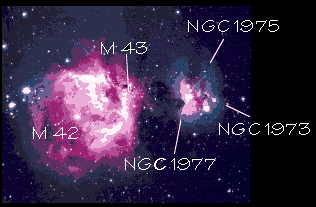NGC 1976
NGC 1982
Orion Nebula
M 42
M 43
Photo: Jason Ware (256k gif)
- RA 5:33, Dec -5:25 (Orion)
- Type: emission nebula
- Distance: 1500 ly
- aka “The Great Nebula in Orion”
- The Orion Nebula is easily visible with the naked eye as the middle star in Orion’s “sword”.
- In this image M 42 (NGC 1976) and M 43 (NGC 1982) appear as one large object. The blue region on the right consists of the reflection nebulae NGC 1973, 1975 and 1977.

- The NOAO image below more clearly shows the separation between M 42 (the larger one) and M 43.
- M 42 is powered by the light from “the Trapezium” (Theta-1 Orionis), a system of four hot, bright, new stars at the heart of the nebula.
- The Orion Nebula is the nearest star formation region to the Earth and consequently particularly well studied. Despite this, star formation is not all that well understood. While these nebulae themselves are huge (many light years across) a nascent solar system is tiny by comparison and hence invisible from the Earth. The HST images below show for the first time small regions that seem to be on the verge of collapsing into stars and perhaps planetary systems.
- The Orion Nebula is actually just part of a much larger cloud that covers most of the constellation of Orion (including the region around the Horsehead Nebula).
- More images at SEDS
- Fabulous HST images from Doug Johnstone.
- Nice HST image of the Trapezium.

NN 248k gif
SEDS 68k gif
(Jason Ware)

AAT html
(David Malin)

AAT 60k html
(David Malin)

UKS html
(David Malin)




HST 78k gif
HST 10k jpg
(caption)

HST 89k gif
HST 12k jpg
(caption)


NOAO 32k jpg
| Bill Arnett | 1997 Nov 18 |
